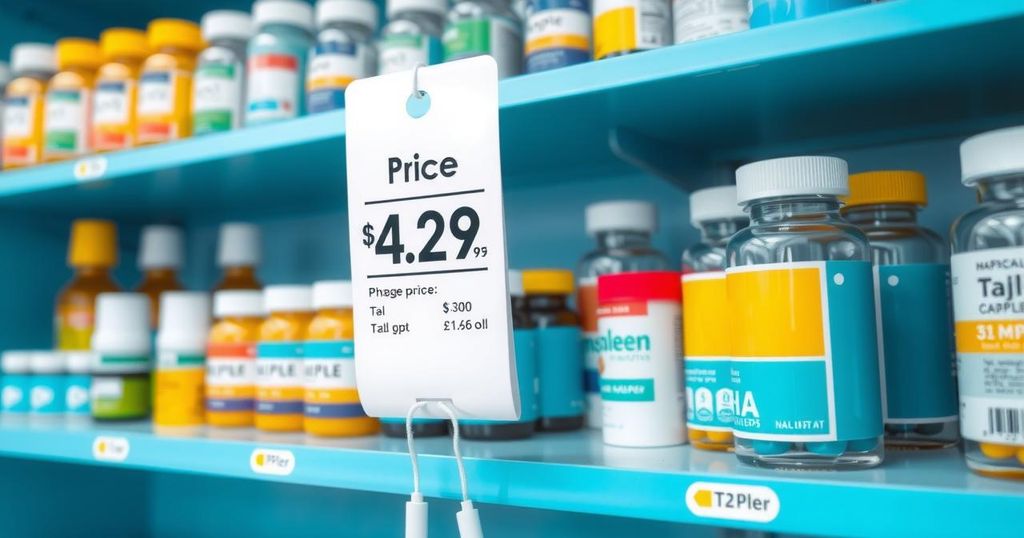The Brazilian government is considering lowering the medicine price ceiling to align with market retail prices, which has raised concerns among pharmaceutical stakeholders regarding competition and the sustainability of small pharmacies. Industry representatives fear potential withdrawal of low-cost medicines and reduced profitability in the sector, particularly affecting independent drugstores. Public consultations are anticipated, while the implications for low-income populations relying on subsidized medications remain a significant concern.
The Brazilian federal government is preparing to discuss a proposal aimed at lowering the maximum allowable price for medicines, which is regulated by the Drug Market Regulation Chamber (CMED) under ANVISA, the country’s health surveillance agency. This initiative seeks to reduce the disparity between the price ceiling and the actual retail prices, where pharmacies often provide an average discount of 30% from the set maximum.
Pharmaceutical retailers and manufacturers express concerns that such a measure might discourage competition and pose risks to small and regional pharmacies. With independent and small-chain drugstores constituting approximately 80% of the sector, a reliance on charging full prices to maximize revenue may leave them disproportionately impacted.
Pharmaceutical companies caution that lowering the price ceiling could lead to the withdrawal of lower-cost medicines from the market, given that several drugs are already offered with narrow profit margins. While CMED is considering adjustments to align the price ceiling with market conditions, officials suggest that any reduction will be modest in order to sustain the existing system of retail discounts.
The discussion regarding drug pricing is not a recent development. A proposal was introduced in 2020 by Senator Fabiano Contarato after the Brazilian Institute for Consumer Protection (IDEC) raised alarms over the significant gap leading to abrupt price hikes during shortages. The topic has resurfaced due to the federal government’s focus on inflation control, identified in January as one of several key regulatory initiatives. Some industry representatives perceive the present discussions as a political maneuver to mitigate negative perceptions tied to rising food inflation.
Within a recent event held by the National Association of Private Hospitals (ANAHP), CMED Executive Secretary Daniela Marreco confirmed active dialogue on the topic, emphasizing prior explorations regarding aligning ceiling prices with actual market prices. “We have debated this extensively, and there is even a bill from 2020 suggesting that CMED should bring the actual market price closer to the ceiling due to the discounts commonly observed,” she stated.
Nelson Mussolini, president of Sindusfarma, the pharmaceutical industry association, countered that the sector had not been adequately consulted on these developments and indicated he opposes the proposal, foreseeing detrimental effects on market competition. He articulated that the implications of lowering the price ceiling may lead to smaller companies being adversely affected, ultimately increasing costs for consumers as well.
Mussolini further articulated his stance, asserting that reducing price ceilings could render the production of certain low-cost medicines economically unfeasible due to production costs potentially exceeding government-mandated prices. In his view, lowering medicine prices will not effectively combat inflation since pharmaceutical inflation remains low and has not significantly influenced the overall inflation rate.
Marreco acknowledged the risks associated with sudden policy changes, noting that jurisdictions which have adopted similar price alignment measures have often witnessed a decrease in manufacturer and retailer discounts. Moreover, such adjustments can incite price increases for previously undervalued medications.
A public consultation regarding a new regulatory framework around medicines is anticipated by mid-year. Any forthcoming changes may be enacted via an interministerial decree involving several governmental entities, including Health, Finance, and Justice Ministries, along with ANVISA. Marreco clarified that ongoing discussions would not affect the established annual price adjustment mechanism governed by Law 10.742 of 2003.
Interfarma, representing the pharmaceutical industry, communicated its lack of awareness regarding formal discussions on amending the price ceiling and asserted potential risks, stating, “Poorly structured pricing policies could lead companies to withhold product launches or even cause supply shortages.” The most significant risk from reducing the price ceiling rests with small, independent pharmacies serving remote areas.
These establishments typically have higher operational costs and limited scale, which complicates their ability to provide drugs at reduced prices. Many small pharmacies rely on maintaining profitability through full-price sales, often only offering discounts as necessary, indicating that a consistently lower pricing model may jeopardize their sustainability.
Brazil hosts approximately 90,000 pharmacies, with 80% classified as micro or small enterprises, many of which are family-run and generate average monthly revenues of around R$60,000. In contrast, larger pharmacy chains reported expecting minimal negative effects from potential policy changes due to their existing competitive pricing strategies.
This discourse on medicine pricing coincides with recent adjustments to the Farmácia Popular program, which sparked concerns from small pharmacies. The Health Ministry’s mandate to expand subsidized products has generated frustration due to delayed reimbursements, complicating financial stability for these businesses, especially in low-income areas.
These delayed reimbursements have seriously disrupted operations for small pharmacies reliant on governmental support, which is vital in maintaining finances, particularly where demand for subsidized medications is significant. In light of concerns from the retail and pharmaceutical sectors, CMED has not responded before this publication. The Brazilian Pharmacy Retail Association (ABRAFARMA) has also refrained from commenting.
The Brazilian government’s proposed adjustments to the price ceiling for medicines have raised significant concerns among pharmaceutical industry stakeholders and independent pharmacies. The potential implications for market competition, affordability, and the sustainability of small drugstores, particularly those servicing low-income communities, are paramount considerations. As discussions progress, the balance between regulatory control, industry viability, and consumer protection will be crucial, especially in achieving an equitable pharmaceutical landscape in Brazil.
Original Source: valorinternational.globo.com




